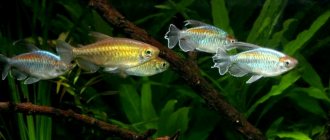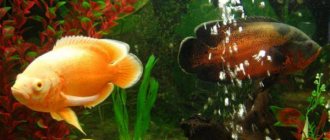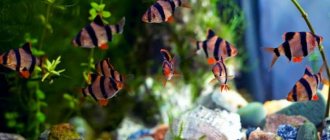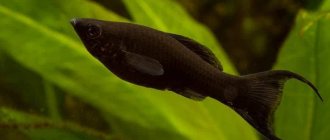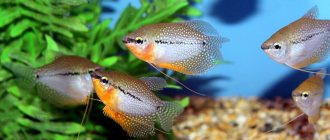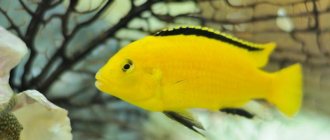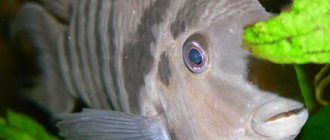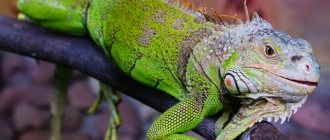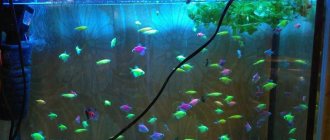Habitat in nature
Kalamoicht calabar lives in western Africa, in the waters of Nigeria and Congo, Angola, Cameroon.
In nature, it lives in stagnant or slow-flowing water, with a low oxygen content, to which the species has adapted and can literally stick its head out of the water to breathe atmospheric oxygen.
The fish has developed lungs, which allow it to even live on land for some time, subject to high air humidity.
The snake fish is an ancient creature that can even be called a fossil. In nature they can grow up to 90 cm in length, in an aquarium they are usually much smaller - about 30-40 cm in length.
Life expectancy is up to 8 years.
Description of the species
It’s worth noting right away that this pet is not for everyone. It is unlikely to appeal to adherents of traditional fish species, conservatives and aquarists suffering from ophidiophobia. But for people who are drawn to the exotic and love to amaze, the Kalamoikht will be an excellent purchase!
In common parlance, the Calabar kalamoicht (lat. Erpetoichthys calabaricus) is better known as the snake fish. Indeed, in appearance it is very similar to a reptile: a long flexible body covered with diamond-shaped scales, a triangular, slightly flattened head and a large mouth.
For complete resemblance, the only thing missing is a forked tongue, but it is missing. Instead, there are small antennae that serve as an organ of touch for the kalamoicht.
The color can be anything from yellow-brown and green to reddish or ocher. There are 8-15 spines on the back just before the tail.
Keeping in an aquarium
Kalamoikhta should be kept in large aquariums.
The fact is that the fish can grow quite large and require a lot of space for swimming.
Adults should be kept in aquariums with a volume of at least 200 liters.
Although they are predominantly nocturnal, with regular feeding during the day they become accustomed and become more active during the day.
But at the same time, kalamoichts are rather timid fish, even shy. It is important to create shelters for them in which they can hide during the day and hide in case of persecution.
You also need soft soil, without sharp edges. Fish can burrow into the ground and it is important that they do not damage their scales.
Remember that fish can easily escape from the aquarium, it is important to tightly close all possible cracks. They can get through cracks that seem impossible to crawl through and travel quite long distances on land.
They tolerate neutral or slightly acidic water well, with a pH of 6.5 - 7.5. Water temperature 24-28°C. In nature, Calabar calamoichts are sometimes found in slightly salty water, for example in river deltas.
Because of this, they are believed to love salt water, but unlike other fish species that live in salt water, they do not tolerate high salt levels well. Preferably no more than 1.005.
Kalamoicht
Kalamoicht calabar is an aquarium snake
. This species is polypterus. It has a long, smooth body, reaching up to 90 cm in length in nature. However, due to its unpretentious nature in an aquarium, it grows up to 30-40cm.
Kalamoichta is often called a snake fish. And the point here is not only in the snake-like structure of the body, but also in the diamond-shaped scales, which, as a rule, have a soft green or brownish tint on the upper part of the body and a beige-yellow tint on the lower abdominal part. The pectoral fins are orange or yellow, giving the kalamoicht a rather funny appearance, since they are located close to the head and look like “ears”. One gets the impression that the fish moves around the aquarium quickly fluttering its ears.
Interesting, active and cute Kalamoikhtas have long become favorite inhabitants of home aquariums.
Compatibility with Alamoikhta : they exist favorably with almost all peaceful species of medium-sized fish. Gets along well with African cichlids. With my own eyes, for the second week now, I have been observing them in a pet store in an aquarium with veil tails. Despite the abundance of teeth in the mouth of the kalamoichta, the tails of the goldfish are intact.
Not compatible with: small fish like neons and guppies. Keeping it with shrimp and snails is also unfavorable. This is a predatory fish and such attractive small specimens can cause a wild appetite in the kalamoichta.
Also, you should not plant two male Kalamoikhtas if there is a female. Whatever one may say, there will only be one male left. It is best to keep a pair. Or buy more females.
How long do they live: Kalamoicht lives on average from 7 to 10 years. But there are cases when they lived up to 15-18 years. You can find out how long other fish live HERE!
Minimum aquarium volume for alamoikhta: from 100 liters. with a wide bottom. In such a volume, a pair of calamoikhts will feel comfortable.
Find out how many fish you can keep in X liters of aquarium HERE (at the bottom of the article there are links to aquariums of all sizes).
Compatibility
It is important to remember that calamoikhtas will hunt fish that they can swallow. Must be kept with medium to large fish, such as synodontis, cichlids or large characinfish.
They get along with such fish without problems and are peaceful. Neons, barbs, shrimp, small catfish are hunted, so don't be surprised if they disappear.
The difference between a male and a female
There are no dorsal and ventral fins, but there is an anal fin, which is used to determine the sex of an individual. If the number of rays on it is 9-12, then it is a female. If there are 12-14 pieces, it’s a male. If there are exactly 12 rays (which often happens), then it depends on your luck.
But gender is not the main thing that an aquarist needs to know, because kalamoichtas do not reproduce in captivity. There have been cases when animals gave birth to offspring in aquarium conditions, but this is rather an exception to the rule.
Calamoichts are bred on special farms or caught in their natural habitat.
Feeding
Due to very poor eyesight, the kalamoichta developed an excellent sense of smell. It prefers live foods such as bloodworms, small worms, and earthworms.
You can also give pieces of shrimp, fish fillets, and squid. Predatory, will hunt small fish and snails.
The biggest difficulty in feeding is its slowness. While he is thinking, the rest of the fish are already finishing their food. Due to poor eyesight and the habit of hiding, kalamoichts are the last to find food.
To prevent them from starving, drop the food directly in front of them, or feed them at night, when they are most active.
This will give them the opportunity to eat normally, since they lose the usual race with fish.
Breeding and sexual characteristics of the Calabar calamoikhta
Sexual differences between a male and a female can be noticed if you look closely at them))). The female has a slightly drooping abdomen and the anal fin is much lighter than that of the males. As a rule, it has a yellowish-olive tint. Also, males have from 12 to 14 dorsal fins, while females have from 9 to 12. The Calabar kalamoichta has no other distinctive sexual characteristics.
Without artificial hormonal stimulation, calamoikhtas do not reproduce outside natural conditions. Over many, many years, very few people have been able to achieve concrete success in breeding them. Therefore, little is known about the “caviar-fish” episode. Already grown kalamoikhts are brought directly from the nooks and crannies of their vast homeland.
Interesting things about the snake...
Near the reservoirs of West Africa, where our Calabar calamoikht settled, legends were made about the strange snake fish. And they were always not to the advantage of the fish themselves.
Being a snake fish in Nigeria is the same as being a black cat in Rus'. Kalamaicht was always killed, mistaking him for something other than who he really was. From afar, Kalamoichta, which is of course not surprising, was often mistaken for just a snake. And in those places, sadly, almost all snakes are poisonous and bring a lot of trouble to local residents.
Over time, the kalamoichta was nevertheless separated from the species of snakes. But the next sentence was still not comforting for him. Superstitious residents, having heard enough fairy tales and legends from traders from the river, could not help but notice some similarities between the kalamoicht and the Chinese serpentine dragon, which punished the unfaithful and wicked, was wise, but impatient.
Without hesitation, the local aborigines came to the conclusion that the Gods were angry with the people of Nigeria and, having pierced the earth, opened a gap in the river into the very heat of the earth, from where justice emerges in the form of Kalamaichts. Nigerians had much to fear. At that time, they sold everything they could. It was then that the trade in gold and diamonds flourished. And their Gods forbade trading their homeland. Frightened people were just waiting for a reason to see the personification of punishment for their sins. And according to the descriptions of the merchant-storytellers, the Serpent is a punisher, well, exactly like a kalamoicht. A long body, wings growing from the head, spikes on the back and tail, lives in water, and is born there from the bowels of the earth.
Mistaking adult, almost meter-long kalamoichts for newborn Snake-Dragons, people have ruined a simply monstrous number of these lovely creatures. There were even special hunters who protected their villages from the Wise Snake.
And yet, one of the oldest fish on our planet, having been both a snake and a dragon, has lived to this day to become an aquarium pet and delight the eye with its grace, agility and unusualness.
Diseases
Before adding a purchased fish to an aquarium, you must first quarantine it. Typically, fish sold in pet stores are caught from the wild and may have dangerous diseases. To facilitate their adaptation to new conditions, special conditioners such as biotopol and acclimol can be added to the water. When treating these fish, it is important to know that they cannot tolerate organic dyes and formaldehyde, as well as salty water.
When choosing a similar fish in a store, you need to take into account its appearance, by which you can determine its illness. Fish covered with matte spots and frayed fringes on the body are infected with parasitic worms or small leeches. In these cases, methylene blue is added to the water and the fish is quarantined.
Reproduction
Cases of breeding in an aquarium have been described, but this is very rare and no system has been identified. Individuals are caught in nature or bred on farms using hormones.
It is almost impossible to even determine their gender.
Kalamoikht is a wonderful fish to keep in a freshwater aquarium. They have unique behavior and habits that you can watch for hours.
With proper care, they can live in an aquarium for up to 20 years.
Today there are many varieties of aquarium fish. Of course, already known species are more popular. For example, these are cockerels, swordtails, guppies, angelfish, golden ones, barbs, various catfish, etc. All of them are known to almost any person, even if he has nothing to do with aquariums. They can be found in every pet store. But sometimes a more experienced aquarist wants something unusual, more interesting.
Of course, it is not easy to find a fascinating representative of the underwater fauna, but they can still be found in Russia. For example, this includes the kalamoicht, which is also called the snake fish.



